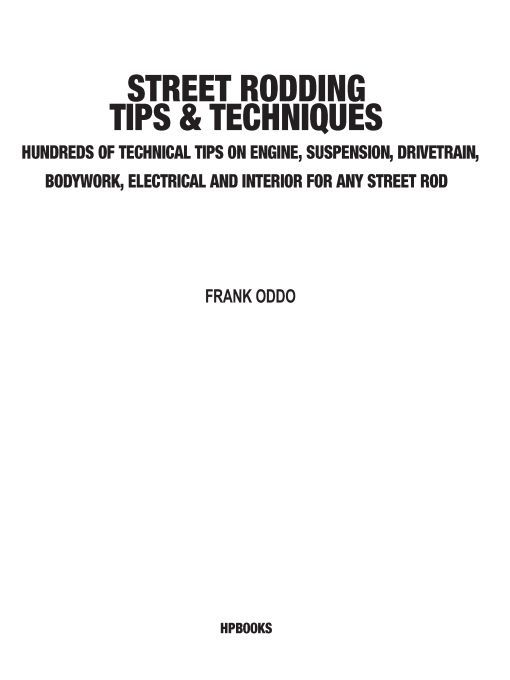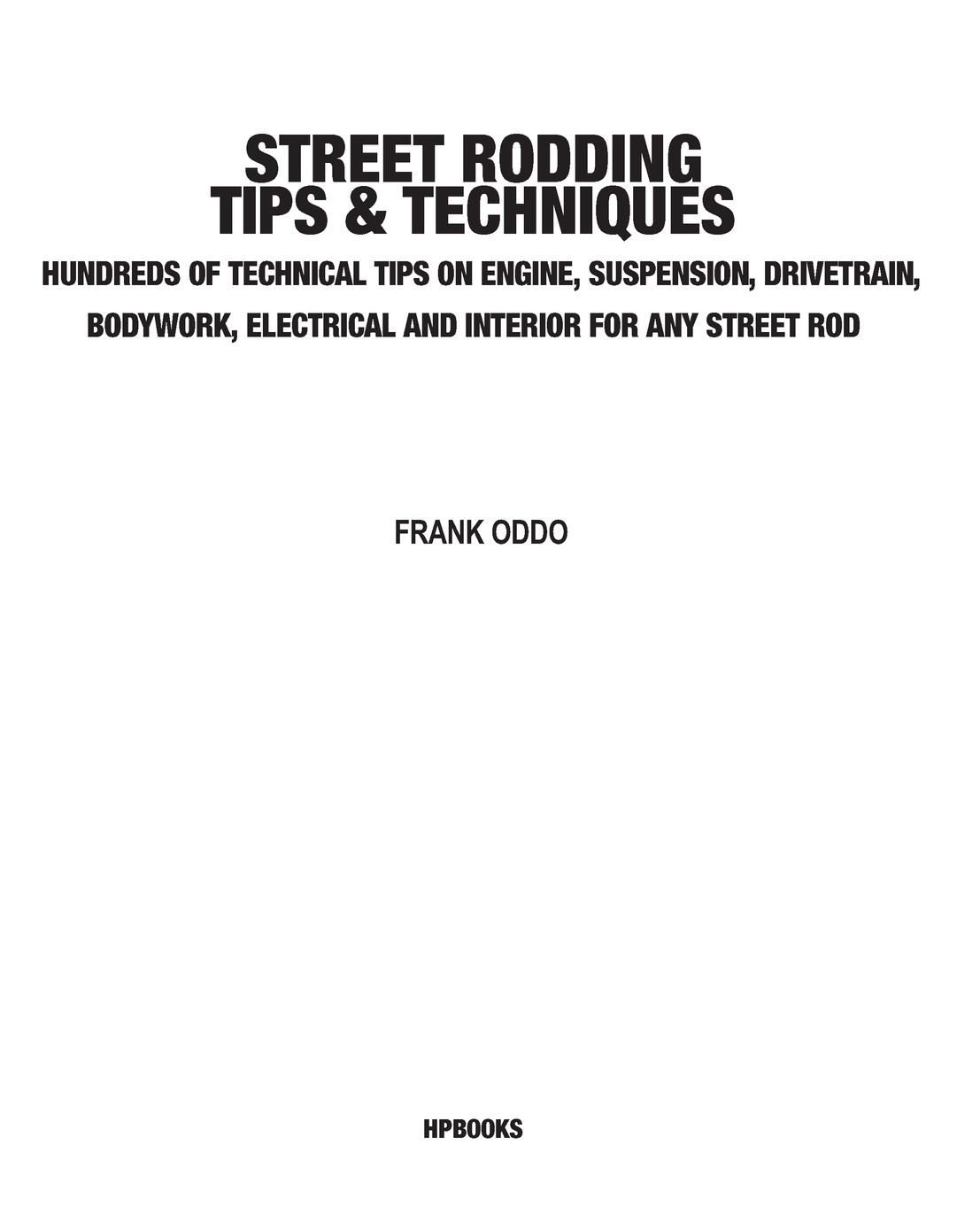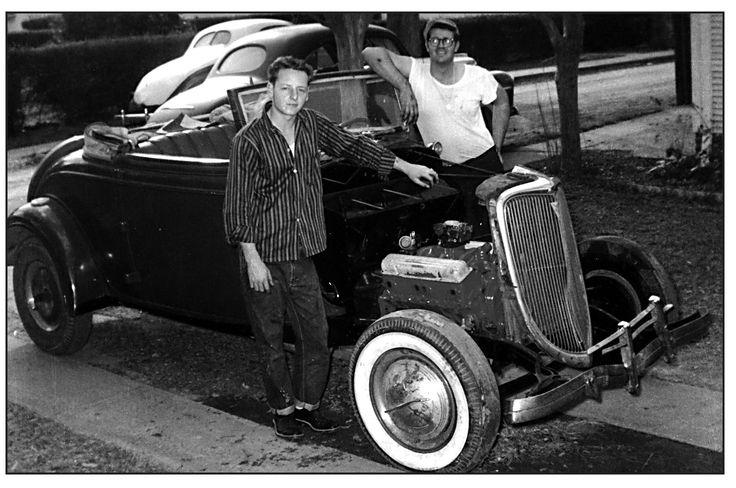Table of Contents
DEDICATION
To Robert J. Rider, my first
street rodding buddy, and the guy
who showed me the difference
between a box wrench and an
open-end.
THE COVER CAR: ROGERS RIDE
Funny thing about the Ford cars for 1937. Those of us, who have been around, know that the 1937 models were, in all honesty, not particularly sought after in the mid-1950s. Oh, how times have changed. Now, Im not going to sit here and tell you that Deuce roadsters and 34 Three-Windows are passed up in the mad rush for a Seven, but nowadays, they darn sure hold their own with their slightly younger post WWII brethren.
Another funny thingof all the Ford V-8 annual production figures for 1932 through 1940, the 1937 count was the largest: 1,037,476! It was Fords best year during the Depression.
Now that would lead the inexperienced to assume there is a 1937 whatever stashed away in every dark SoCal garage. Not hardly. In fact, Roger Fulmer of Brea, California, only found his in a Hemmings advertisement. And it was not exactly in his neighborhood. In fact, of the 33,683 DeLuxe Tudors that rolled out of Dearborn in 1937 with a window sticker of $580, he had to fly to Dallas, Texas, to consummate the deal! Roger knew what he wanted, and he went after it.
Rogers Tudor is the epitome of the mild-mannered, super reliable street rod that makes every like-minded hobbyists pulse quicken. Let me tell you a little about it.
A closer look at the car reveals that it is not quite as stock as it may first appear. The body is completely shaved, with flush Honda door handles, and a Porsche fuel tank door thrown in for kicks.
The original 1937 frame was rehabilitated and boxed by Limeworks of Whittier, California. The independent front suspension and steering is a Total Cost Incorporated Mustang II styled assembly with rack and pinion steering. The rear is a Versailles 9-inch with parallel leaf suspension, and 3.50:1 gearing.
The engine is a basically stock 1989 Merc 302 with an Edelbrock intake manifold, 4V carb and polished rocker covers. Stepping away from the crowd in the search for reliability, Roger decided to stay with the stock cam and electronic ignition. The engine was built by Hails Machine Shop of Fullerton. Keeping with the tractable theme, the transmission is a B & M shifted, rebuilt but stock 1989 Merc AOD.
The sheet metal was brought to perfection by Vintage Auto of Brea and then sprayed with Dark Cherry acrylic. The dark maroon leather upholstery was tailored by Modern Trim of Whittier over a stock Honda front seat and a much-modified Cadillac Seville rear seat. The rest of the interior is what might be expected for a gentleman of leisurepower front windows, A/C, VDO instruments, a custom console and a GM steering column.
No wonder Rogers grandson Keith Cousins looks the car over with unabashed awe. Dont you?
INTRODUCTION
The primary purpose of these pages, a companion to the Street Rodders Handbook, is to pass on further (and sometimes re-emphasize) bits of practical information to the builder of, and chief wench on, a mainstream street rod. They have been selected for the fellow who labors day and night to first get his car on the road, and then (hopefully) at a more leisurely pace to keep it in top form. And too, when the temptation to upgrade becomes too great to ignore!
It is assumed that the typical reader is one who is familiar with basic automotive mechanics and tools, but more importantly, enjoys working on his street rod. He has to, for designing, building and maintaining a street rod is a hobby that consumes time and energy, to say nothing of money.
The first piece of advice is given in recognition of the novice rod builders initial hurtledetermining the size and scope of the project into which he is about to throw himself. Sure, he knows that a full-boogie rework of an old car, or ground-up assembly of a reproduction requires many hours of garage time and operating capital, but he invariably underestimates the total! I call this tip my Rule of Three: No matter how long you think it will take, or how much you think it will cost, if you are going to do it well, multiply your best guess by three.
Failure to be realistic is why some projects never make it to graduation day. Therefore, you just might want to set your sights a little lower than an expectation of perfection. Of course it would be great to build and own a supercharged, chrome-plated, double-overhead-cam powerhouse mounted in a frame with state-of-the-art suspension, surrounded by a flawless body gorgeously painted and upholstered; in short, an award-winning showpiece featured on the cover of your favorite car magazine.
Instead, think about how much fun it will be to build and own a safe, reliable, reasonably comfortable old car that has enough moxey to scare off the rice-burning jelly bean next to you at the stoplight. Maybe your car is only primered, but its got smooth sheet metal. Maybe the seat covers are a Wal-Mart Special, but theyre clean. Maybe only driving it, and planning one mechanical or cosmetic upgrade at a time, would be more fun than just looking at a bunch of parts for a few more years. This may not be the stuff of which rod mag features are made, but man, its Reality 101.
The second piece of advice I want to impart is also something I learned the hard way. It sounds deceptively simple... but it isnt. Decide what it is that you want to do with your street rod from the get-go.
Do you want an honest to goodness daily driver? I mean a car you can jump in every morning and go to work, rain or shine. (I know that concept may be outdated, but to my way of thinking, there is no more pure street rodding fun.) If that is your aim, remember a daily cruiser has a conservative powerplant; it idles smoothly and is easy on the gas. Sure, it has enough beans to hold its own in traffic, but first and foremost, it is reliable.
On the other hand, you may want a weekend cruiser, a slightly different breed of car. Typically, it is a rod with more horsepower than one really needs for transportation, but enough to provide its owner with his jollies at club meetings, rod runs, and the like where maximum tractability is not at the top of his want list.
Finally, there is the street rod that looks like a race car. (Or is it the other way around?) These are built by guys who want to do more than just strut their stuff, they want to get down and dirty in that much maligned contest of speed.
I love em all! And, Lord knows, Ive tried to have it all at one time or another during my life. As a consequence, Ive learned the hard way; you cant have it all in one car. Like they say at the carnival, Yer pays yer money, and yer makes yer choice. The point is... get started. There are a thousand things youll have to do before you back the car out of the garage... and a hundred changes youll want to make after youre up and running. Just keep things in perspective.
The third piece of advice is short and sweet: Promise yourself to complete at least one task a day, even if its only to tighten a bolt. Youll get the car up and running with a minimum of downtime.


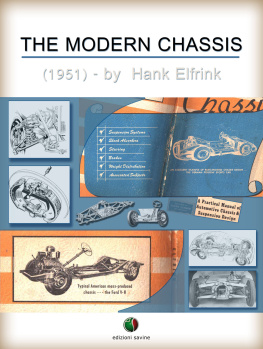

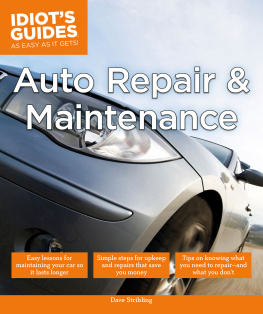


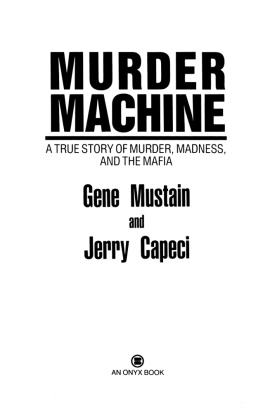
![Harry Turtledove - Worlds that werent : [novellas of alternate history]](/uploads/posts/book/79050/thumbs/harry-turtledove-worlds-that-weren-t-novellas.jpg)



